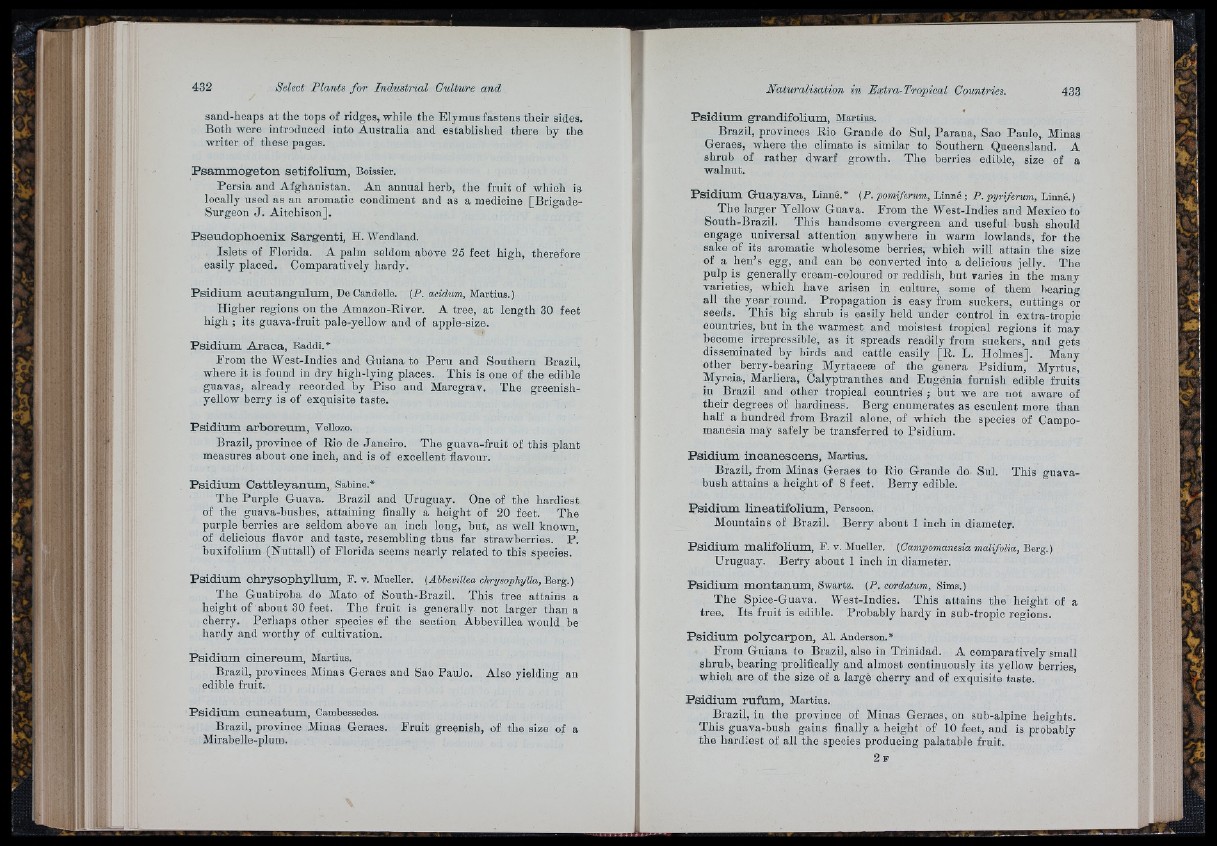
sand-heaps a t the tops of ridges, while the Elymus fastens their sides.
Both were introduced into Australia and established there by the
writer of these pages.
P s am m o g e to n s e tifo lium , Boissier.
Persia and Afghanistan. An annual herb, the fruit of which is
locally used as an aromatic condiment and as a medicine [Brigade-
Surgeon J . Aitchison].
P s e u d o p h o e n ix S a rg e n ti, H. Wendland.
Islets of Plorida. A palm seldom above 25 feet high, therefore
easily placed. Comparatively hardy.
P s id ium a c u ta n g u lum , De Candolle. (P. acidum, Martius.)
Higher regions on the Amazon-River. A tree, at length 30 feet
high ; its gnava-fruit pale-yellow and of apple-size.
P s id ium A ra c a , Raddi.*
From the West-Indies and Guiana to Peru and Southern Brazil,
where it is found in dry high-lying places. This is one of the edible
guavas, already recorded by Piso and Marcgrav. The greenish-
yellow berry is of exquisite taste.
P s id ium a rh o re um , Vellozo.
Brazil, province of Rio de Janeiro. The gnava-fruit of this plant
measures about one inch, and is of excellent flavour.
P s id ium C a ttle y a n um , Sabine.*
The Purple Guava. Brazil and Uruguay. One of the hardiest,
of the guava-bushes, attaining finally a height of 20 feet. The
purple berries are seldom above an inch long, but, as well known,
of delicious flavor and taste, resembling thus far strawberries. P.
huxifolium (Nuttall) of Florida seems nearly related to this species.
P s id ium c h ry s o p h y llum , P. v. Mueller. (AhbcvUlea chrysophylla, Berg.)
The Guabiroba do Mato of South-Brazil. This tree attains a
height of about 30 feet. The fruit is generally not larger than a
cherry. Perhaps other species of the section Abbevillea would be
hardy and worthy of cultivation.
P s id ium c in e re um , Martius.
Brazil, provinces Minas Geraes and Sao Paulo,
edible fruit.
Also yielding an
P s id ium o u n e a tum , Cambessedes.
Brazil, province Minas Geraes.
Mirabelle-plum.
Fru it greenish, of the size of a
P s id ium g ra n d ifo lium , Martius.
Brazil, provinces Rio Grande do Sul, Parana, Sao Paulo, Minas
Geraes, where the climate is similar to Southern Queensland. A
shrub of rather dwarf growth. The berries edible, size of a
walnut.
P s id ium G u a y a v a , Linné.* [P. pomiferum, Linné; P. pyrifcrum, Linné.)
The larger Yellow Guava. From the West-Indies and Mexico to
South-Brazil. This handsome evergreen aud useful bush should
engage universal attention anywhere in warm lowlands, for the
sake of its aromatic wholesome berries, which will attain the size
of a hen’s egg, and can be converted into a delicious jelly. The
pulp is generally cream-coloured or reddish, but varies iu the many
varieties, which have arisen in culture, some of them bearinu
all the year round. Propagation is easy from suckers, cuttings or
seeds. This big shrub is easily held under control in extra-tropic
countries, bnt in the warmest and moistest tropical regions it may
become irrepressible, as it spreads readily from suckers, and gets
disseminated by birds and cattle easily [R. L. Holmes]. Many
other berry-bearing Myrtaoeæ of the genera Psidium, Myrtus,
Myrcia, Marliera, Calyptranthes and Eugenia furnish edible fruits
in Brazil and other tropical countries ; but we are not aware of
their degrees of hardiness. Berg enumerates as esculent more than
half a hundred from Brazil alone, of which tbe species of Campo-
manesia may safely be transferred to Psidium.
P s id ium in o a n e so e n s , Martius.
Brazil, from Minas Geraes to Rio Grande do Sul.
bush attains a height of 8 feet. Berry edible.
This guava-
P s id ium lin e a tifo lium , Persoon.
Mountains of Brazil. Berry about 1 inch in diameter.
P s id ium ma lifoRum , F. v. Mueller. (Campomanesia malifolia, Berg.)
Uruguay. Berry about 1 inch in diameter.
P s id ium m o n ta n um , Swartz. (P. cordatum, Sims.)
The Spice-Guava. West-Indies. This attains the height of a
tree. Its fruit is edible. Probably hardy in sub-tropic regions.
P s id ium p o ly c a rp o n , Al. Anderson.*
From Guiana to Brazil, also in Trinidad. A comparatively small
shrub, bearing prolifically and almost continuously its yellow berries,
which are of the size of a large cherry and of exquisite taste.
P s id ium ru fum , Martius.
Brazil, in the province of Minas Geraes, ou sub-alpine heights.
This guava-bush gains finally a height of 10 feet, and is probably
the hardiest of all the species producing palatable fruit.
2 p